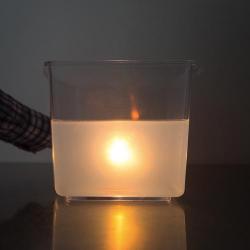Source Institutions
Source Institutions
Add to list Go to activity
Activity link broken? See if it's at the internet archive

In this optics activity, learners explore why the sky is blue and the sunset is red, using a simple setup comprising a transparent plastic box, water, and powdered milk. Learners use a flashlight to shine a beam of light through the container. Learners look at the beam from the side of the container and then from the end of the tank, and compare the colors that they see. Learners also examine a narrower beam of light. Use this activity to introduce learners to the light spectrum, wavelengths, frequency, scattering, and how all this effects what we see in the sky at different times of the day.
- 10 to 30 minutes
- 30 to 45 minutes
- $1 - $5 per group of students
- Ages 8 - 14
- Activity
- English
Quick Guide
Materials List (per group of students)
- A transparent plastic box, or a large beaker, jar, or aquarium
- A flashlight or projector (either a slide or filmstrip projector)
- Powdered milk
- Polarizing filter (such as the lens from an old pair of polarized sunglasses)
- Blank white card for image screen
- Paper hole-punch
- Unexposed (black) 25 mm slide or photographic film, or an index card cut to slide size (optional)
Subjects
-
Earth and Space Science
-
Earth Structure
- Atmosphere
- Earth, Moon and Sun
-
Earth Structure
-
Life Sciences
- Human Body
-
Human Senses and Perception
- Vision
-
Physical Sciences
-
Vibration and Waves
- Wave Properties
-
Light and Optics
- Electromagnetic Spectrum
- Sunlight and Color
-
Structure and Properties of Matter
- Elementary Particles and Nuclear Physics
-
Vibration and Waves
-
The Nature of Science
-
The Scientific Process
- Conducting Investigations
-
The Scientific Process
Audience
To use this activity, learners need to:
- see
- see color
- touch
Learning styles supported:
- Involves hands-on or lab activities
Other
This resource is part of:
Access Rights:
- Free access
By:
Rights:
- All rights reserved, The Exploratorium,
Funding Sources:
- National Science Foundation
- California Department of Education
- NEC Foundation of America
